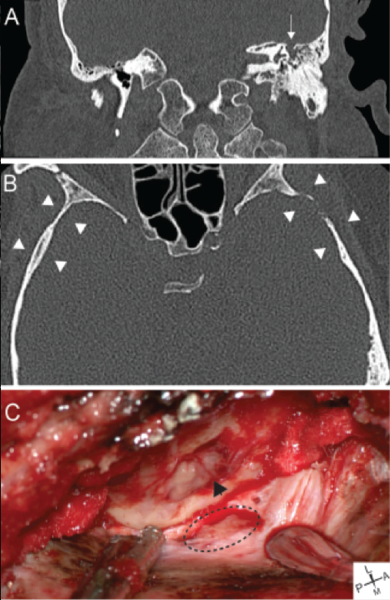What is the optimal approach and perioperative care for repair of skull base spontaneous cerebrospinal fluid (sCSF) leaks?

(click for larger image)
Figure 2: Representative images from a patient with a lateral sCSF leak. (A) Representative coronal CT showing left tegmen mastoideum defect (arrow) with fluid in the middle ear and mastoid. (B) Axial CT demonstrating cortical skull thinning (arrowheads). (C) Intraoperative images showing tegmen defect with encephalocele (arrowhead) and dural defect (dotted line).
Copyright 2017 The American Laryngological, Rhinological and Otological Society, Inc.
Bottom line
Endoscopic repair of anterior skull base leaks and MCF or transmastoid approaches for lateral skull base leaks have a high success rate of repair. In most cases, intraoperative placement of lumbar drain did not appear to result in improved success rates for either anterior or lateral skull base leaks
Explore This Issue
May 2017Background: The clinical presentation of sCSF leak should be recognized, and its diagnosis involves a combination of clinical history, a skull base defect on high resolution computed tomography (CT) and associated clear pulsatile otorrhea or clear rhinorrhea. Unlike traumatic or iatrogenic leaks, sCSF leaks are highly associated with obesity and idiopathic intracranial hypertension. The safety and efficacy of surgical treatment of sCSF leaks has not been systematically evaluated, and the use of intra-operative fluorescein and peri-operative CSF diversion are controversial.
Study design: A systematic review of English articles using MEDLINE. Search terms included spontaneous, CSF, cerebrospinal fluid, endoscopic, middle fossa, transmastoid, leak, rhinorrhea. Independent extraction of articles by three authors.
Synopsis: Patients with sCSF leaks are often obese (average BMI of 38 kg/m2) and female (72%). Many patients also have obstructive sleep apnea (∼45%) and many have elevated intracranial pressure when measured by lumbar puncture (Figure 2, above). In addition to thinning of the skull base, radiographic studies also demonstrate cortical bone thinning. Endoscopic surgical repair of anterior skull base leaks and middle cranial fossa (MCF) approach for repair of lateral skull base leaks are safe and effective with an average short-term failure rate of 9% and 6.5%, respectively. Long-term failure rates are low. One randomized trial failed to show improved success of anterior leak repairs with the use of a lumbar drain (LD) (95% with vs. 92% without; P = 0.2). In a large retrospective cohort of MCF lateral skull base repairs, perioperative LD use was not necessary in >94% of patients.
Citation: Lobo BC, Baumanis MM, Nelson RF. Surgical repair of spontaneous cerebrospinal fluid (CSF) leaks: A systematic review. Laryngoscope Inv Otol. March 2017. doi: 10.1002/lio2.75.